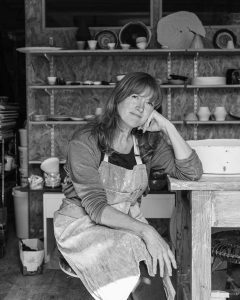
In Focus – Pastello by Curiousa
 darc caught up with Esther Patterson of Curiousa to talk about the brand’s latest launch, Pastello. A beautiful collection of porcelain lights in a mix of signature and new colours that are quickly becoming a signature aesthetic of the studio. Discover details of Patterson’s inspirations behind the collection and the manufacturing processes the pieces went through to create the desired finishes
darc caught up with Esther Patterson of Curiousa to talk about the brand’s latest launch, Pastello. A beautiful collection of porcelain lights in a mix of signature and new colours that are quickly becoming a signature aesthetic of the studio. Discover details of Patterson’s inspirations behind the collection and the manufacturing processes the pieces went through to create the desired finishes
What is the concept behind this new collection?
Drawing on the studio’s signature colour palette from the award-winning Maya and Carnival collections, Pastello pairs hand-crafted ceramic and semi-opaque glass shades in a spectrum of pastel tones.
The inspiration behind the range’s palette harks back to the playful, optimistic colours of 1950s and 60s melamine tea sets, picnic scenes and coloured bathroom suites — a celebration of bravery, joy and the desire to brighten life after dark times.
We’re inviting homeowners and designers to channel that same boldness, creating bathrooms that lift the spirit and inspire the day ahead. This range embodies my love of colour, texture and playful form, bringing a sense of joy and individuality to any bathroom.
How long have you been working on Pastello for?
I’ve been experimenting with the shade shapes for the last 18 months. I make the original shape on the wheel; in ceramic slip-casting terms we call this the model or master. I create a solid shade shape in brown clay, then cast from this using plaster. I use this plaster mould to slip cast my ceramic shades using a beautiful porcelain clay called Parian. This clay was originally used for Victorian doll heads in the 18th century as it self-glazes and has a smooth, slightly translucent glowing finish.
What challenges did you face when producing this collection?
The first shades I made were cone-shaped, but when lit, there was a horrid shadow at the top and the shade wasn’t evenly lit. The lamp holder was creating a shadow, so I decided to start again and create a space at the top to allow room for the holder and to light the shade more evenly.
It worked. I made a simple dish and bowl shape – the Ciao and Hola – in this style. Originally, I experimented with using these for our Siren wall lights but then realised the potential for a simple spotlight-style light, so I created one with a swivel to make it directional.
I could really see the potential for these in bathrooms or bedside lighting – a simple and versatile visual addition to a room, using colour to create a pop of interest without taking up much space.
Tell us more about the materials and how you work with ceramics and glass in your studio.
What’s great about slip-casting is that you can make many pieces from one mould, and I can keep experimenting with each one. I’ve started painting some of the surfaces too. For instance, for the Hola, I decided to paint a layer of colour on the inside of the shade while it was still in the mould. I was just playing, but it turned out so well that I decided it would become part of the Pastello range, creating a simple two-tone shade. I’ve also started hand-painting designs on the shades and I’m thinking of bringing out a range of these next year. Because I make the models myself on the wheel, the final shades still carry the maker’s marks and impressions. I don’t want them to look factory made, but handmade.
What inspired you to introduce new colours into the collection?
It often starts with the colour and I work from there, sketching silhouettes in my pad first. Most of the palette stems from the previous Maya Collection, but I’ve added one more – Eggplant. The deep purple is an interesting mix with the diffused glass and ceramic pieces.
For me, colour is the stuff of life. It brings me joy, and I love the art of combining colours in a daring way. It’s a challenge sometimes to bring so many colours together, but when it works, I love it. We’ve even created a new strapline for ourselves: The Colour Lighting Company.
What makes these products different to other lighting pieces on the market?
All the prototype lights are made in my ceramic studio in Wirksworth, Derbyshire. For larger orders, I work with George Woolley (DINK), who used to work for Curiousa but now runs his own ceramic studio in Sheffield. I love that we keep things local and handmade to order.
There are a lot of white porcelain lights out there, and some of them are very beautiful, but not many coloured. My gut tells me we’ll see more of them soon, as I think this style will catch on. But for now, I believe we’re one of the first among my UK design contemporaries to offer porcelain shades with such a broad colour choice, all made to order.



